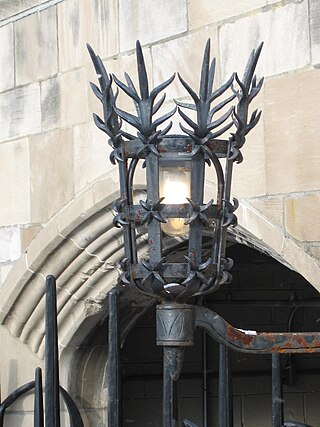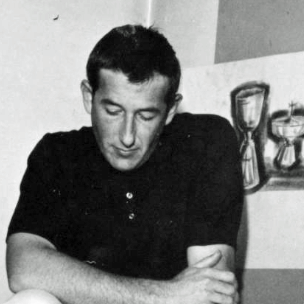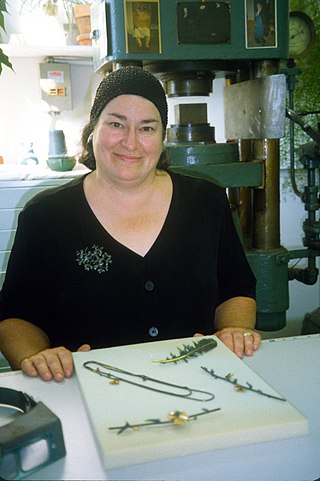Related Research Articles

Samuel Yellin (1884–1940), was an American master blacksmith, and metal designer.

John Axel Prip, also known as Jack Prip (1922–2009), was an American master metalsmith, industrial designer, and educator. He was known for setting standards of excellence in American metalsmithing. His works and designs have become famous for bringing together the formal, technical tradition of Danish design into harmony with the American desire for innovation. Several of his designs for the Reed and Barton Company are still in production today.

Albert Paley is an American modernist metal sculptor. Initially starting out as a jeweler, Paley has become one of the most distinguished and influential metalsmiths in the world. Within each of his works, three foundational elements stay true: the natural environment, the built environment, and the human presence. Paley is the first metal sculptor to have received the Lifetime Achievement Award from the American Institute of Architects. He lives and works in Rochester, New York with his wife, Frances.
Chunghi Choo is a jewelry designer and metalsmith who was born in Incheon, Korea in 1938. She received a BFA degree from Ewha Womans University in Seoul, Korea, where she majored in Oriental painting and studied philosophy of Oriental art and Chinese brush calligraphy. She moved to the United States in 1961 to study metalsmithing, weaving, and ceramics at Cranbrook Academy of Art in Bloomfield Hills, Michigan, where she received an MFA in 1965.
Robert Ebendorf is an American metalsmith and jeweler, known for craft, art and studio jewelry, often using found objects. In 2003–2004, the Smithsonian American Art Museum organized an exhibition of 95 pieces, titled The Jewelry of Robert Ebendorf: A Retrospective of Forty Years.
Boris Bally is an American artist and metal smith in Providence, Rhode Island.
Madison Fred Mitchell belonged to the New York School Abstract Expressionist artists whose influence and artistic innovation by the 1950s had been recognized around the world. New York School Abstract Expressionism, represented by Jackson Pollock, Willem de Kooning, Franz Kline and others became a leading art movement of the post-World War II era.
John Rais is a designer, blacksmith and sculptor known for his architectural work, vessels, and furniture. Rais primarily works in steel as well as titanium, bronze, copper, stainless steel, and other materials. He is well known for his one-of-a-kind firescreens. Rais was born and raised in Burlington, Massachusetts, the youngest of seven children. Rais was introduced to blacksmithing in a sculpture class at the age of 18. He went to college at the Massachusetts College of Art, graduating in 1995, BFA Sculpture. After working at an architectural ironworks and a living history museum in Massachusetts, he decided to go to graduate school. Rais received his masters of fine arts degree from Cranbrook Academy of Art in 1998, after which he worked at Peters Valley Craft Center as a department head. Rais was a department head of blacksmithing at Peter's Valley from 1998 to 2001. He has run his own design and metalsmithing studio since 1998. He now resides in Philadelphia, PA.

Mary Lee Hu is an American artist, goldsmith, and college level educator known for using textile techniques to create intricate woven wire jewelry.

L. Brent Kington was an art educator and visual artist who worked in blacksmithing and sculpture. Kington was a product of the studio craft movement in jewelry and hollowware. In 1969 he served as the first president of the Society of North American Goldsmiths. He is frequently hailed as the man responsible for the blacksmithing revival which took place in the late 1960s and early 1970s.

Fred Fenster is a metalsmith and professor emeritus of the University of Wisconsin at Madison where he taught art and education. He is particularly known for his work in pewter, influencing generations of metalsmiths. Fenster was named a Fellow of the American Craft Council in 1995.
George Earl Ortman was an American painter, printmaker, constructionist and sculptor. His work has been referred to as Neo-Dada, pop art, minimalism and hard-edge painting. His constructions, built with a variety of materials and objects, deal with the exploration off visual language derived from geometry—geometry as symbol and sign.
Heikki Markus Seppä, also known as Heiki Seppa was a Finnish-born American master metalsmith, educator, and author. He taught at Washington University in St. Louis, from 1965 to 1992.
Gary Lee Noffke is an American artist and metalsmith. Known for versatility and originality, he is a blacksmith, coppersmith, silversmith, goldsmith, and toolmaker. He has produced gold and silver hollowware, cutlery, jewelry, and forged steelware. Noffke is noted for his technical versatility, his pioneering research into hot forging, the introduction of new alloys, and his ability to both build on and challenge traditional techniques. He has been called the metalsmith's metalsmith, a pacesetter, and a maverick. He is also an educator who has mentored an entire generation of metalsmiths. He has received numerous awards and honors. He has exhibited internationally, and his work is represented in collections around the world.
Harriete Estel Berman is an American artist known for her sculptures and jewelry made from post-consumer, recycled household goods, and her satirical explorations of women's roles in society.
Myra Mimlitsch-Gray is an American metalsmith, artist, critic, and educator living and working in Stone Ridge, New York. Mimlitsch-Gray's work has been shown nationally at such venues as the John Michael Kohler Arts Center, Museum of the City of New York, Metropolitan Museum of Art, Cooper-Hewitt Smithsonian Design Museum, and Museum of Arts and Design. Her work has shown internationally at such venues as the Middlesbrough Institute of Modern Art, Stadtisches Museum Gottingen, and the Victoria and Albert Museum, and is held in public and private collections in the U.S, Europe, and Asia.
Linda Threadgill is an American artist whose primary emphasis is metalsmithing. Her metal work is inspired by forms of nature and the interpretations she gleans from the intricate patterns it presents. She explores the foundation of nature to allude to nature and transform it into re-imagined, stylized plants forms.

Jan Yager is an American artist who makes mixed media jewelry. She draws inspiration from both the natural world and the lived-in human environment of her neighborhood in Philadelphia, Pennsylvania, emphasizing that art is a reflection of both time and place. She has incorporated rocks, bullet casings, and crack cocaine vials into her works, and finds beauty in the resilience of urban plants that some would consider weeds.
Sharon Church was an American studio jeweler, metalsmith, and educator. She is a professor emerita of the University of the Arts (Philadelphia) in Philadelphia, Pennsylvania. In 2012, Church was elected a Fellow of the American Craft Council (ACC). In 2018, she received a Lifetime Achievement Award from the Society of North American Goldsmiths.

Society of North American Goldsmiths is an organization of jewelers and metal artists in North America. It is located in Eugene, Oregon.
References
- 1 2 "Stanley Lechtzin". Smithsonian American Art Museum (SAAM). Retrieved 2021-12-15.
- 1 2 3 4 "Stanley Lechtzin". Craft In America. 2012-08-03. Archived from the original on 2012-08-03. Retrieved 2021-12-15.
- ↑ Drutt English, Helen. "Oral history interview with Stanley Lechtzin".
- ↑ "Tyler Crafts Dept. : M/J/C-C Area : Faculty : Lechtzin : Resume". Archived from the original on 2007-08-19. Retrieved 2008-04-09. - Tyler School of Art abridged resume page
- ↑ "Biography: Stanley Lechtzin". Archived from the original on 2003-01-22. Retrieved 2008-04-09. - Tyler School of Art Biography page for Stanley Lectzin
- ↑ - Society of North American Goldsmiths website
- ↑ "Brooch, ca. 1966". Metropolitan Museum of Art.
- ↑ "Torque #33 D". Yale University Art Gallery. Retrieved 2021-12-15.